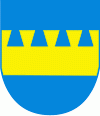Kerava
 |
The town has a population of 0 and covers an area of undefined km2 of which undefined km2 is water. The population density is undefined PD/km2. Kerava is the 30th largest municipality in terms of population, but the 5th smallest municipality in terms of area in Finland (and the second smallest in the Uusimaa region after Kauniainen). However, it is also the third most densely populated area in the sub-region after Helsinki and Kauniainen. The municipality is unilingually Finnish.
The Sinebrychoff brewery operations are based in Kerava. There is also a well-known prison in the town (Keravan vankila), which includes 94 places in the open prison ward.
Until the Middle Ages, Kerava was a wilderness, until two villages, Ylikerava ("Upper Kerava") and Alikerava ("Lower Kerava"), were created along the Kerava River (Keravanjoki). The first signs of established village settlement date back to the 1440s. Kerava was annexed to Tuusula when the Tuusula parish was founded in 1643. In 1862, the railway between Helsinki and Hämeenlinna was opened, which quickly brought industry to agricultural Kerava; the carpentry factory in Kerava was established in 1908, and the wood industry became an important factor in the development of the town. The coat of arms designed by Ahti Hammar features a woodworking joints made by a carpenter.
In 1924, Kerava was separated from Tuusula as its own township. At that time, it had a population of about 3,000. Originally, it also included part of the Korso area, and Korso railway station was also located in the township area. However, from 1954 onwards, the entire Korso was annexed to the then Helsinki Rural Municipality. During the peak periods of the late 1960s and 1970s, the population almost doubled due to immigration and good transport connections, and new suburbs were created in Kurkela, Kilta and Untola. Kerava was officially granted town rights in 1970.
Map - Kerava
Map
Country - Finland
 |
 |
| Flag of Finland | |
Finland was first inhabited around 9000 BC after the Last Glacial Period. The Stone Age introduced several different ceramic styles and cultures. The Bronze Age and Iron Age were characterized by contacts with other cultures in Fennoscandia and the Baltic region. From the late 13th century, Finland became a part of Sweden as a consequence of the Northern Crusades. In 1809, as a result of the Finnish War, Finland became part of the Russian Empire as the autonomous Grand Duchy of Finland, during which Finnish art flourished and the idea of independence began to take hold. In 1906, Finland became the first European state to grant universal suffrage, and the first in the world to give all adult citizens the right to run for public office. After the 1917 Russian Revolution, Finland declared independence from Russia. In 1918, the fledgling state was divided by the Finnish Civil War. During World War II, Finland fought the Soviet Union in the Winter War and the Continuation War, and Nazi Germany in the Lapland War. It subsequently lost parts of its territory, but maintained its independence.
Currency / Language
| ISO | Currency | Symbol | Significant figures |
|---|---|---|---|
| EUR | Euro | € | 2 |
| ISO | Language |
|---|---|
| FI | Finnish language |
| SV | Swedish language |
















